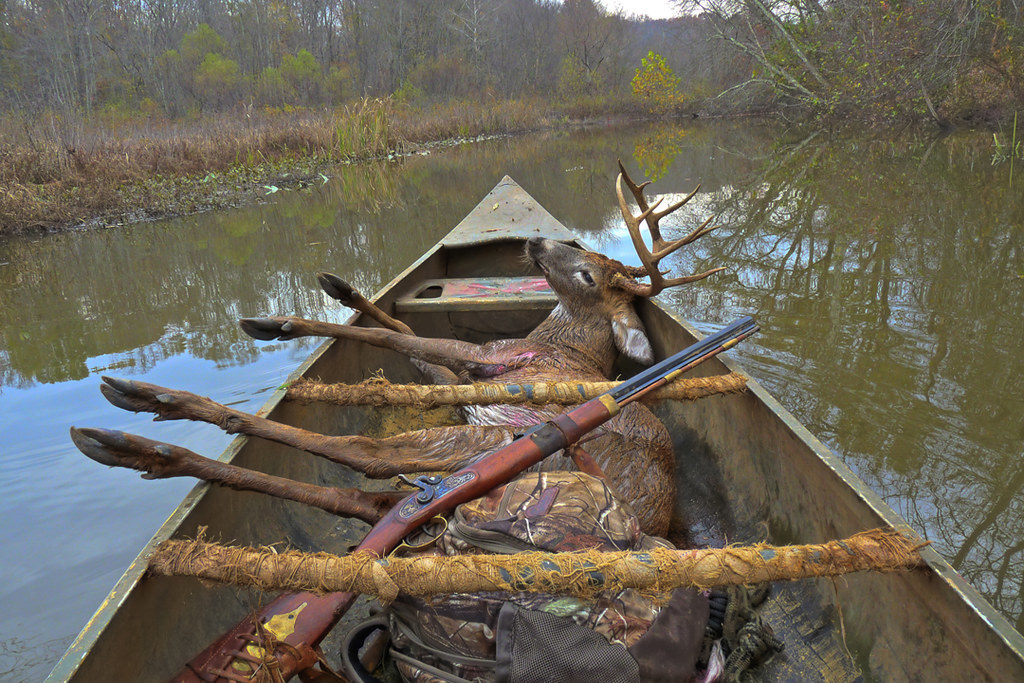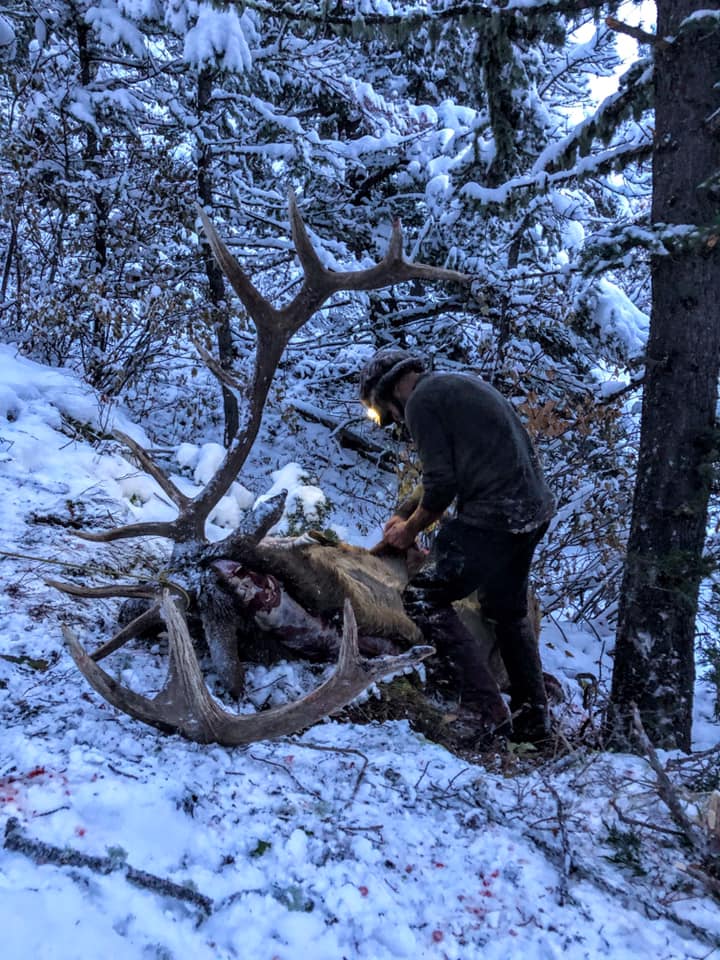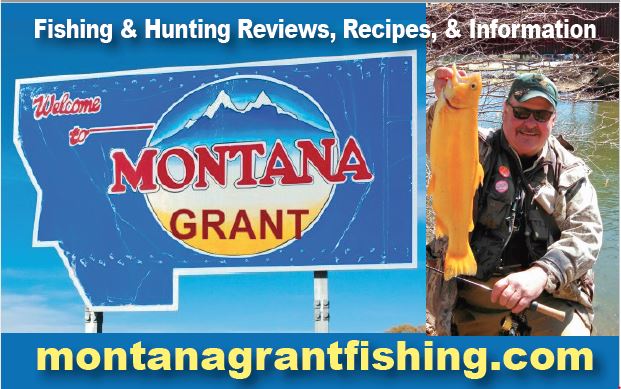13 Nov GETTING THE BUCK OUT!!!
Once the critter is down, now what? Trophy critters require assistance when getting them from the field to your rig. Back in the pioneer days, a horse, wagon, or mule may have been handy. Today, we need to consider other options.

We have all heard the stories about the guy that shoots the big buck that runs back toward his truck and falls into the bed. Anything even close to this has never happened to me.
Years ago, I traveled to the top of Martin’s Mountain, Pennsylvania, early one morning. Opening day meant big crowds and moving deer. I picked a spot well above the hunters and waited for the morning drive. Sure enough, dozens of deer were pushed uphill, right into my lap. One well placed shot and my tag was in place. Now it was time to drag my big whitetail back to the truck, 4 miles away.
The path was rugged and covered with blowdowns and rockpiles. I used an old looped safety strap around the buck’s neck, and over my shoulder. The dressed buck weighed 142 lbs. It gained weight with every step. By the time it was back to camp, there was no hair left on its sides. It looked like a hairless cat. Even though the hair was gone, the hide protected the meat. Surely there had to be a better way.

Over the years, we tried roll out plastic sleds, poles, quartering, two-man carts, travois, and anything we could think of to get the critters out. Today, we are blessed with a menu of special rigs, carts, sleds, and gear to make this task easier. If you hunt on private land, a wheeler, truck, or farm equipment will do the trick. Public land discourages vehicle use.
On another Evitts Mountain adventure hunt, in Maryland, I nailed my morning buck and tried to haul it out in a more traditional way. Hopefully, no hair would be dragged off, this time. We have all seen the pictures of hunters returning to camp with a critter tied to a pole. They hauled it over their shoulders and shared the load. No one ever mentions how the critters sway as you walk. Up and down hills transfer the weight. This is an idea that looks better than it works. We busted our butts carrying this swinging buck several miles to the car.
Farmers, ranchers, and private landowners seem to always have a tractor, dozer, super wheeler, or some rig to haul the critters. On one Montana elk hunt, the landowner had several family members lined up across a ridgetop, on opening day. I went along as a helper. Over 100 elk came down the coulee at first light. Everyone opened up and 12 bulls were down. The landowner’s son, Jon, ran back to the barn and drove back in a front-end loader. They hooked up 4 bulls at a time to the front and hauled them back to the barn. I am not sure how sporting this hunt was but the haul out was sure easier. What I do remember is that the matriarch of the family, Leonard, waited for everyone else to shoot. After they were done, Leonard used shooting stix, and a 300 WinMag, to drill his bull at 1000 yards!
Most hunters do not have the advantage of horses, tractors, or front-end loaders. We must rely on muscle and ingenuity. Wheelers help, if allowed. Wheeled carts are handy. Wheelbarrows work, and maybe a winch. On one haul out adventure, a buddy nailed a huge 5×5 buck at the bottom of a valley. Instead of attempting a carry or drag, we attached a rope to the winch on my wheeler and ran 4 lengths of climbing rope to the deer. The deer’s front legs were folded over the antlers to streamline the drag. My buddy was with the deer, and a radio. When I got the word to winch, I flipped the switch. Before you knew it, the buck and Buddy were on their way up the steep hill. At a few points during the drag, Darryl had lost his footing and just held on. Both hands were needed to hold on so he couldn’t use the radio. I stopped as the winch wheel filled and re-tied the rope. It took some time but neither of us broke a sweat.
Planning ahead of time, for a haul out, is a good idea. If you have a waterway, road, trail, or downhill topography in your area, know where to go with the flow. After one successful morning, I hauled my buck to the shore of a lake. It was in the opposite direction of the camp. My buddy was already at camp with his buck. Our canoe was at our camp, across the lake. Before you knew it, he was paddling over to me, and my buck. The deer was loaded and floated home.
Railroad Hollow, in Green Ridge State Forest, Maryland has a 10-mile blocked road. Perfect for a bicycle access. I rode my fat tired, camo painted, 1930’s bike mid-way and hid it under a hemlock tree. After filling my buck tag. I loaded the deer onto my bike. The rear body cavity perched on the seat. The head and antlers piled into the front bike basket. This bike had no gears. I was able to role the deer for 5 miles with minimal effort. When there was a downhill slope, I was able to stand on the pedal and glide with my buck.
You can’t beat a sled in the snow. Sturdy plastic tuff sleds come in all sizes and can later double up as ice fishing sleds. On one cow elk haul out, we manhandled a huge elk to a fire road. Once there, this guy pulls out a little, pink, plastic kiddie sled. We loaded the whole critter onto the sled. Most was hanging off. I was able to tow the whole 500 pound plus cow elk with one hand. The problem came when going downhill. The critter wanted to toboggan to the bottom.
Wheeled carts come in all kinds of configurations. Some have hand brakes. The wider the wheelbase, the better. Narrow rigs tend to dump over. Lower center of gravity carts works best. Fold up carts allow easier mobility. On several opening day antelope hunts, we hauled out up to 4 lopes at a time on a wheeled cart. We would haul the folded cart into the field before light. It would hang on a fence until needed. Once we haul pulled our triggers, the lopes were shuttled to a loading spot. We all took turns hauling the loaded sled back to the truck.
Having some gloves, and extra cord to secure the meat, are also handy. The best thing to have are some strong hunting partners. The more muscle, the easier the haul. Share the meat with whoever helps.
If you are young and strong enough, throw the critter over your shoulders and begin the long walk. If the critter is too big, quarter it and bag it. Carry it out 100 pounds at a time. Use an old pack frame or shoulder rig. The meat you must work hard for always tastes better.
Hunt hard, hunt harder!
Montana Grant
For more Montana Grant, haul him in at www.montanagrantfishing.com.


